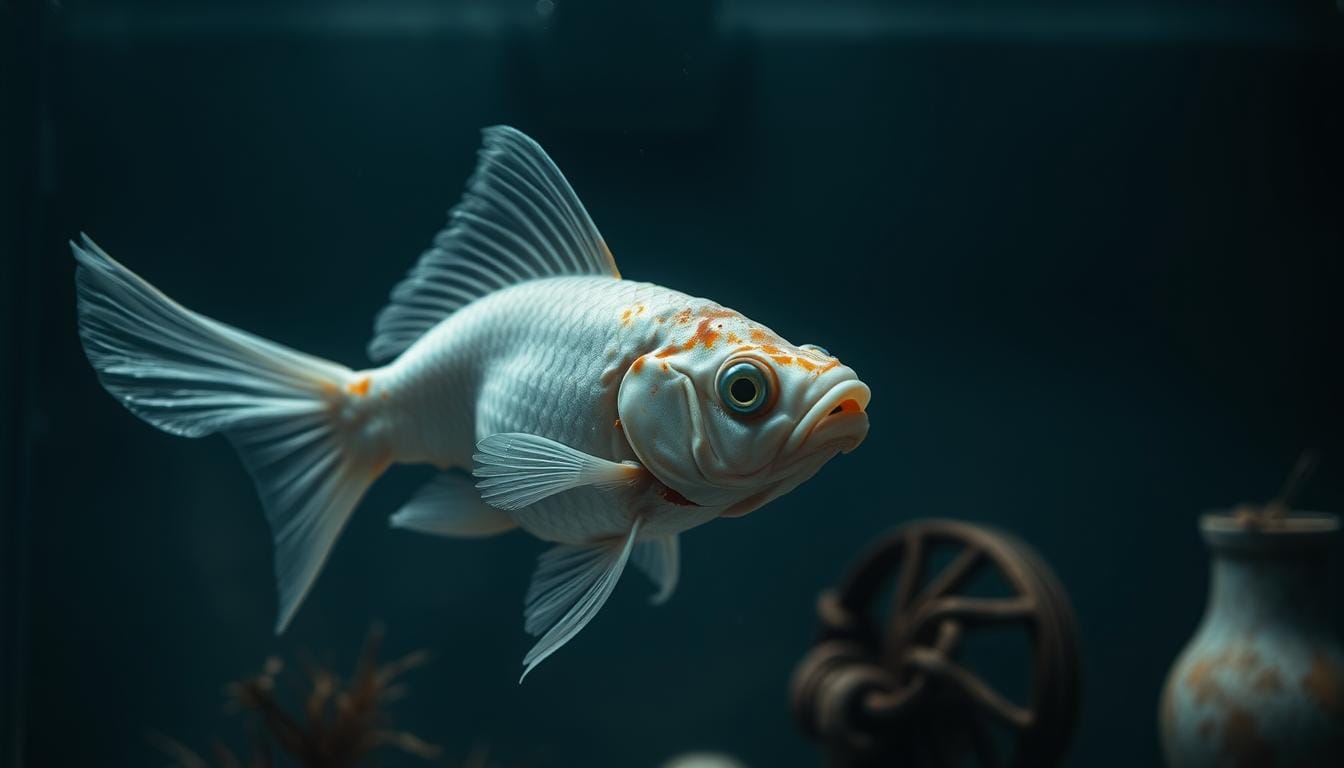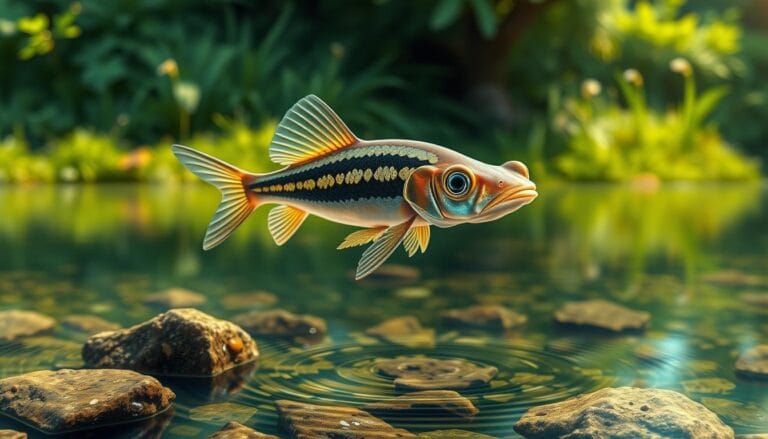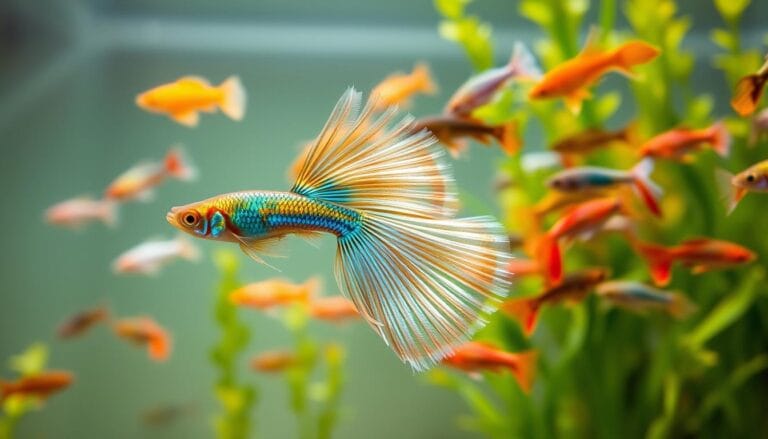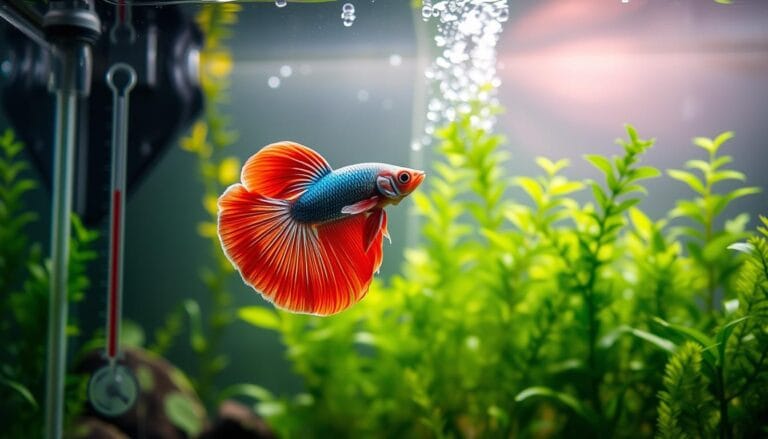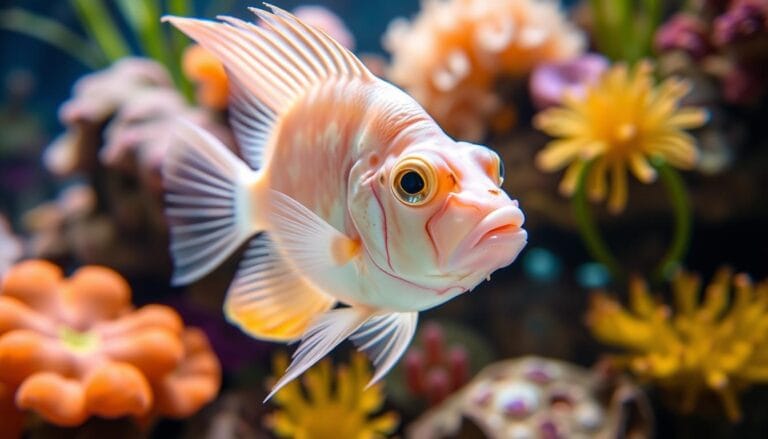Best Ways to Heal a Diseased White Goldfish Fast
As a goldfish owner, you know how vital it is to keep your pet healthy and happy. But, even with good care, your white goldfish can get sick. If you see your goldfish acting tired, not eating, or breathing hard, you must act fast. This helps stop the disease from spreading and gets your pet better quickly.
Table of Contents
Spotting and treating illness early is key to keeping your tank healthy. By noticing signs of sickness and acting quickly, you can help your goldfish get better. This article will show you the best ways to care for a sick white goldfish. We’ll cover treatment options and how to prevent future illnesses.
Understanding Your Diseased White Goldfish
As a goldfish owner, it’s key to know the signs of illness in your pet. White goldfish often get sick with bacterial and fungal infections. If your goldfish seems tired, won’t eat, or has trouble breathing, act fast to avoid worse problems.
Some common signs of illness in white goldfish include:
- Lethargy or lack of energy
- Loss of appetite or difficulty eating
- Labored breathing or rapid gill movement
- Changes in color or appearance, such as white scales
White goldfish are more likely to get sick because they’re sensitive and might have genetic issues. Keeping their tank clean and healthy can stop many diseases.
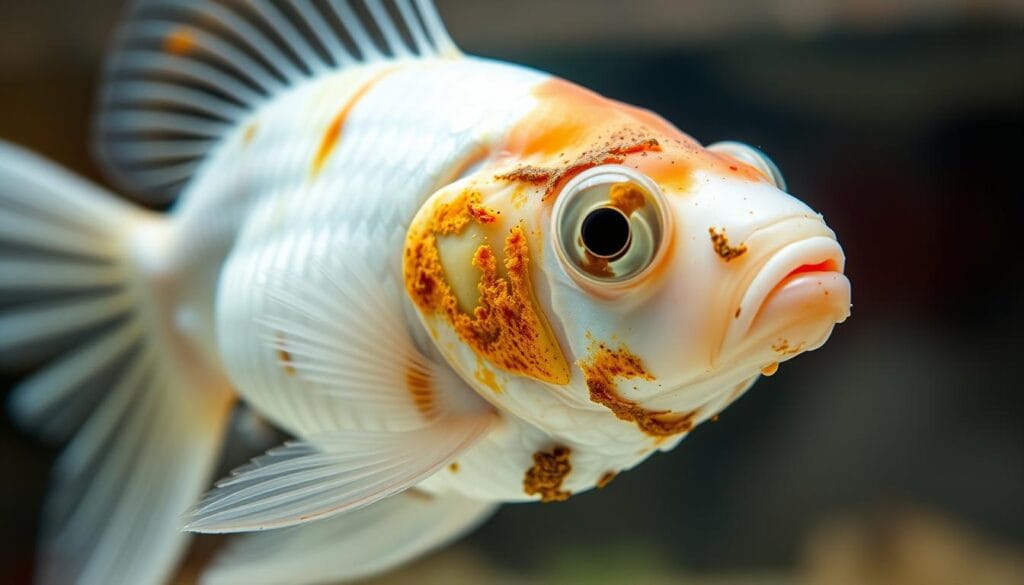
By spotting illness signs early and acting quickly, you can help your white goldfish get better. Make sure they eat well, keep their water clean, and get help from a vet if you’re not sure about their health.
Emergency Steps to Take When Your Goldfish Shows Signs of Illness
If your goldfish looks sick, it’s critical to act fast. You need to set up a quarantine tank and use medicines to treat the illness. Experts say a quarantine tank stops diseases from spreading. This is because new fish often carry sicknesses without showing symptoms.
Signs of illness in goldfish include hard breathing, being very tired, and not wanting to eat. Seeing these signs means you should start treatment right away. Use medicines like Maracyn, ParaCleanse, and Ich-X to fight off bacteria, parasites, and other diseases.
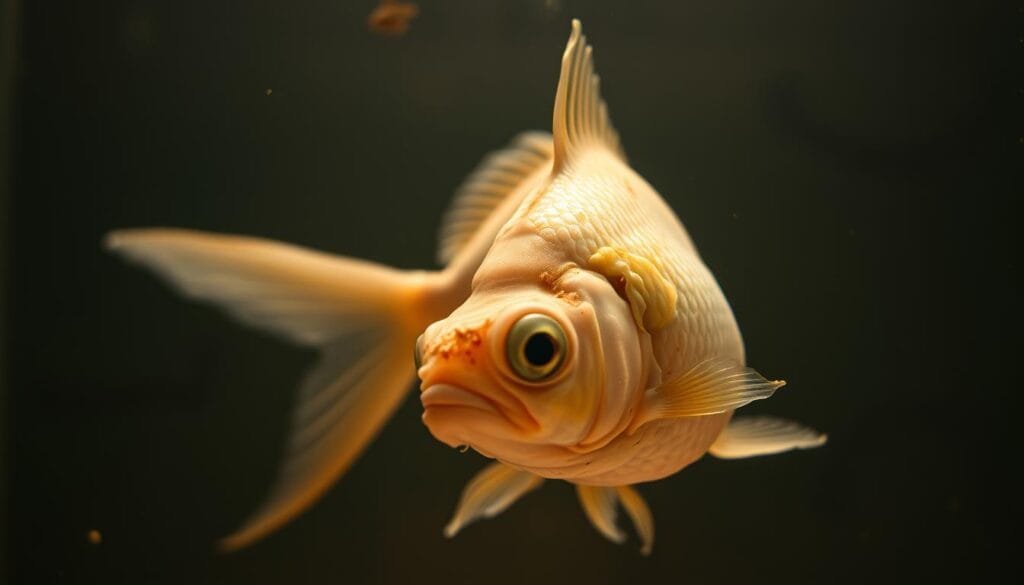
Keeping the water clean is also key to stopping disease spread. Do regular water changes, check the water’s health, and don’t overfeed. These steps help keep your goldfish safe and healthy.
Here are some key steps to treat goldfish diseases:
- Put the sick fish in a quarantine tank
- Follow the directions for using medicines
- Keep the water clean and healthy
- Watch the fish closely and change treatment if needed
Common Diseases Affecting White Goldfish
As a goldfish owner, knowing about common diseases is key. Diseased white goldfish can get bacterial, fungal, parasitic, and viral infections. Keeping the water clean is very important.
Look out for signs like missing scales, flashing, and lethargy. If you see these, act fast to help your goldfish.
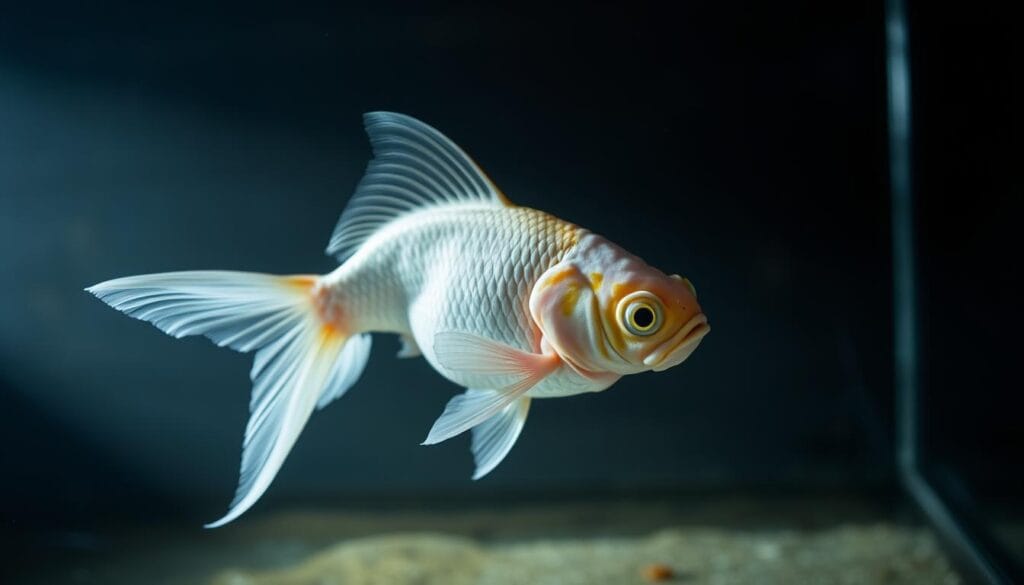
Bacterial Infections
Bacterial infections can show as red streaks and cloudy eyes. They can be treated with antibiotics. But, fixing the water quality is also important.
Fungal Diseases
Fungal diseases, like white fungus, show as white growths. Treatments include salt baths or dips. The choice depends on the disease’s severity.
Parasitic Infections
Parasites like protozoa and worms can infect goldfish. Symptoms include flashing and lethargy. Keeping your tank clean is key to avoiding parasites.
Viral Conditions
Viral diseases, like polycystic kidney disease, are serious. They can cause tissue damage and have no cure. Keeping the water clean and the environment healthy is vital.
Water Quality Management for Sick Goldfish
Keeping the water quality right is key when your goldfish is sick. Bad water can stress them out, which can make them sicker. To avoid this, make sure the water is clean and well-filtered. This helps keep your fish healthy.
It’s important to watch the levels of ammonia and nitrite in the water. They should be very low, below 0.25 ppm. Nitrates should also be kept low, under 50 ppm. Changing the water a bit, about 20% each week, helps keep it clean. Also, having a good filter system is vital for keeping the water healthy.
By following these tips, you can help your goldfish get better. Remember, stopping diseases before they start is the best way. Regular care and watching your tank can cut down disease risk by up to 60%. Good water quality is the first step to a healthy goldfish.
Here are some important tips to remember:
- Maintaining a kH of at least 80 ppm, with over 160 ppm being preferable
- Keeping a GH of 200 ppm or higher for optimal goldfish health
- Maintaining an optimal pH range of 7.0 to 7.8, with stability being more important than exact numbers
Medication and Treatment Options
When your white goldfish gets sick, it’s key to look into different treatments. You can find over-the-counter options at pet stores. These can help ease symptoms and fight off common diseases.
Aquarium salt is a common treatment for sick goldfish. It’s often mixed with other meds. For example, a 0.3% solution of aquarium salt can fight Ich disease, a common parasite. Methylene Blue and Malachite Green can also treat fungal infections and other diseases.
It’s important to know that not all treatments work the same. Some may need a mix of meds to work best. For instance, to treat Ich disease, you might need to raise the water temperature and add aquarium salt. Methylene Blue or Malachite Green might be needed for fungal infections. Always follow the recommended dosage and treatment time for the best results.
Some common treatments for sick goldfish include:
- Over-the-counter treatments, such as aquarium salt and meds like Methylene Blue and Malachite Green
- Prescription meds for more serious cases
- Natural remedies, like better water quality and less stress, to boost the fish’s immune system
Always talk to a vet before treating your sick goldfish. They can guide you on the best treatment and help keep your fish healthy.
Proper Feeding During Recovery
When your goldfish is getting better from diseases, it’s key to feed them right. A balanced diet with various nutrients helps them get strong again. It’s important not to overfeed, as it can cause stomach problems and harm their health.
Feed your goldfish 2-3 times a day, letting them eat in 3-5 minutes. If they’re weak or young, feed them small amounts often. This helps avoid health issues like fatty livers.
- Give them a balanced diet with different nutrients.
- Don’t overfeed to avoid stomach problems.
- Feed small amounts often, more for weak or young fish.
- Stay away from diets high in energy.
By following these tips, you can help your goldfish get better from diseases. Always put your goldfish’s health first. If you’re unsure, get professional advice.
Quarantine Tank Setup and Management
Setting up a quarantine tank is key when a white goldfish gets sick. This tank keeps the disease from spreading to other fish. It also lets you focus on treating the sick fish. The size of the tank depends on the fish’s size, ranging from 10-20 gallons for small fish.
Keeping the water clean is important. You should change 10-20% of the water every week. If the fish is getting treatment, you might need to change it more often. Watching the fish every day helps spot any signs of illness, like not wanting to move or not eating.
It’s best to keep new or sick fish in quarantine for 4-6 weeks. This makes sure all diseases are treated before they go back to the main tank. You’ll need a sponge filter for cleaning and a heater to keep the water at a steady temperature. Adding hiding spots, like PVC pipes or plants, can also help the fish feel less stressed.
When to Seek Professional Help
As a goldfish owner, it’s key to know when your fish is very sick. Fish diseases can be hard to spot and treat, even for experts. If your fish shows signs like hard breathing, being very tired, or visible injuries, get help from a vet right away.
About 70% of new fish may carry diseases without showing symptoms. This shows how important it is to watch your fish closely and keep their tank clean. Goldfish often get bacterial infections, which are a big problem.
Here are some signs you should get help for your goldfish:
- Visible wounds or injuries
- Labored breathing or rapid gill movement
- Lethargy or loss of appetite
- Changes in color, shape, or size
Getting help from a vet can really help your goldfish get better. A vet can figure out what’s wrong and suggest the best treatment. Remember, acting fast is very important. Waiting too long can lead to serious problems, even losing your fish.
Prevention Strategies for Future Health
To keep your goldfish healthy, it’s key to create a clean environment and care for them well. Regularly changing the water and cleaning the tank can stop diseases from spreading. Also, feeding them a balanced diet with good food boosts their immune system.
Here are some important steps to prevent diseases in goldfish:
- Regular water changes to keep the water quality right
- Proper tank cleaning to avoid harmful bacteria and parasites
- A balanced diet with high-quality food for strong health
- Quarantining new fish to stop diseases from entering the main tank
By taking these steps, you can lower the chance of your goldfish getting sick. This way, they can stay healthy and happy.
Long-term Care for Recovered Goldfish
As a goldfish owner, you know how vital it is to care for your pet, even after it’s recovered. A diseased white goldfish needs extra attention to avoid future sickness. To keep your goldfish healthy, focus on maintaining good water quality, feeding a balanced diet, and regular tank upkeep. Web sources say polluted water is the main cause of goldfish diseases, so changing the water often is key.
To keep your goldfish in top shape, ensuring the water quality is optimal is essential. This means doing regular water changes, checking the water’s condition, and not overcrowding the tank. Also, feeding a diet that’s right for your goldfish can help prevent diseases.
Regular tank maintenance is also critical to stop disease spread. This includes cleaning the tank, watching your goldfish’s behavior, and isolating new fish. These actions help keep your goldfish disease-free.
Some important long-term care tips include:
- Regular water changes to keep the water quality high
- Feeding a balanced diet that meets your goldfish’s needs
- Regular tank maintenance, like cleaning and behavior checks
- Quarantining new fish to prevent disease spread
By following these tips, you can ensure your goldfish stays healthy and disease-free. A happy goldfish is a healthy one, and with the right care, you can enjoy your pet for many years.
Conclusion: Ensuring Your White Goldfish’s Swift Recovery
Caring for a sick white goldfish needs quick action and a detailed plan. Knowing the common diseases and taking emergency steps are key. Proper treatment and management help your goldfish get better.
Keeping water quality high, feeding right, and reducing stress are important. These steps help your goldfish recover and stay healthy.
With the right knowledge and care, your white goldfish can quickly get better. Be alert, act fast, and consult a vet if needed. Good care means a happy, healthy goldfish that brings joy for years.
There are no reviews yet. Be the first one to write one.

